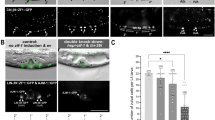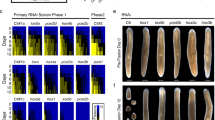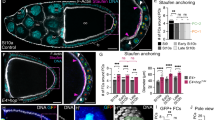Abstract
IN the nematode Caenorhabditis elegans six hypodermal cells, the vulval precursor cells, are each competent to generate vulval cells1–2. Normally only the three nearest precursor cells to the uterine anchor cell generate the vulva (22 nuclei), while the three others fuse with the non-specialized hypodermal syncytium (hyp7) surrounding each precursor cell and covering the body1,3. Without an inductive signal from the anchor cell, all six vulval precursor cells fuse with hyp7 and no vulva is formed1,4. But without activity of the vulval determination gene lin-15(+), all six cells undergo vulval divisions whether the anchor cell is present or not5–8. Using mosaic analysis, we demonstrate here that lin-15(+) expression is necessary in cells other than the vulval precursor cells or the anchor cell, most probably in the hyp7 syncytium. We propose that lin-15(+) is active in hyp7 in order to repress an intrinsic vulval program in the precursor cells. The inductive signal from the anchor cell counteracts this repression for three precursor cells, allowing them to generate vulval cells (Fig. 1a). Such a two-signal (repressor/derepressor) mechanism may operate in other cases of tissue induction.
This is a preview of subscription content, access via your institution
Access options
Subscribe to this journal
Receive 51 print issues and online access
$199.00 per year
only $3.90 per issue
Buy this article
- Purchase on Springer Link
- Instant access to full article PDF
Prices may be subject to local taxes which are calculated during checkout
Similar content being viewed by others
References
Sulston, J. E. & White, J. G. Devl Biol. 78, 577–597 (1980).
Sternberg, P. & Horvitz, H. R. Cell 44, 761–772 (1986).
Sulston, J. E. & Horvitz, H. R. Devl Biol. 56, 110–156 (1977).
Kimble, J. Devl Biol. 87, 286–300 (1981).
Ferguson, E. & Horvitz, H. R. Genetics 110, 17–72 (1985).
Ferguson, E., Sternberg, P. W. & Horvitz, H. R. Nature 326, 259–269 (1987).
Ferguson, E. & Horvitz, H. R. Genetics 123, 109–121 (1989).
Sternberg, P. W. & Horvitz, H. R. Cell 58, 679–693 (1989).
Greenwald, I. S., Sternberg, P. W. & Horvitz, H. R. Cell 34, 435–444 (1983).
Sternberg, P. W. Nature 335, 551–554 (1988).
Herman, R. K. Genetics 108, 165–180 (1984).
Sulston, J. E., Schierenberg, E., White, J. G. & Thomson, J. N. Devl Biol. 100, 64–119 (1983).
Herman, R. K., J. Neurogenet. 5, 1–24 (1989).
Kim, S. K. & Horvitz, H. R. Genes Dev. 4, 357–371 (1990).
Fixsen, W., Sternberg, P., Ellis, H. & Horvitz, R. Cold Spring Harb. Symp. quant. Biol. 50, 99–104 (1985).
Waring, D. A. & Kenyon, C. Cell 60, 123–131 (1990).
Greenwald, I. S. & Horvitz, H. R. Genetics 96, 147–164 (1980).
Herman, R. K. Genetics 116, 377–388 (1987).
Hedgecock, E. M., Culotti, J. G., Thomson, J. N. & Perkins, L. A. Devl. Biol. 111, 158–170 (1985).
Perkins, L. A., Hedgecock, E. M., Thomson, J. N. & Culotti, J. G. Devl. Biol. 117, 456–487 (1986).
Greenwald, I. S. & Horvitz, H. R. Genetics 113, 63–72 (1986).
Villeneuve, A. M. & Meyer, B. J. Genetics 124, 91–114 (1990).
Albert, P., Brown, S. & Riddle, D. J. comp. Neurol. 198, 436–451 (1981).
Kenyon, C. Cell 46, 477–487 (1986).
Author information
Authors and Affiliations
Rights and permissions
About this article
Cite this article
Herman, R., Hedgecock, E. Limitation of the size of the vulval primordium of Caenorhabditis elegans by lin-15 expression in surrounding hypodermis. Nature 348, 169–171 (1990). https://doi.org/10.1038/348169a0
Received:
Accepted:
Issue Date:
DOI: https://doi.org/10.1038/348169a0
This article is cited by
-
Distinct IFT mechanisms contribute to the generation of ciliary structural diversity in C. elegans
The EMBO Journal (2007)
-
Visualization of C. elegans transgenic arrays by GFP
BMC Genetics (2006)
-
Chromatin regulation and sumoylation in the inhibition of Ras-induced vulval development in Caenorhabditis elegans
The EMBO Journal (2005)
-
Isopentenyl-diphosphate isomerase is essential for viability of Caenorhabditis elegans
Molecular Genetics and Genomics (2005)
-
Synaptic code for sensory modalities revealed by C. elegans GLR-1 glutamate receptor
Nature (1995)
Comments
By submitting a comment you agree to abide by our Terms and Community Guidelines. If you find something abusive or that does not comply with our terms or guidelines please flag it as inappropriate.



